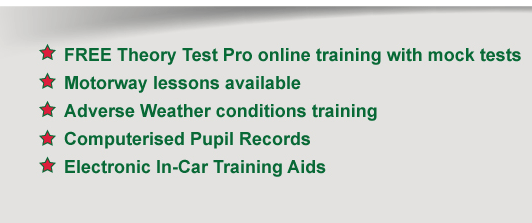
The Practical Driving Test
1. Overview
The practical driving test is designed to see if you:
- can drive safely in different road and traffic conditions
- know the Highway Code and can show this through your driving ability
As long as you show the standard required, you’ll pass your driving test.
There’s no minimum number of lessons you must have or hours you must practice driving before you take your test. There are no pass or fail quotas.
2. Documents to bring to your test
You must bring:
- your theory test pass certificate (or confirmation) if you’re not exempt from taking the theory test
- both parts of your driving licence - the photocard and the paper counterpart
You must take your signed driving licence and a valid passport if you have an old-style paper licence.
Your test will be cancelled and you’ll lose your fee if you don’t bring the right documents.
3. What happens during the test
Before you start the driving ability part of your test, you’ll have an eyesight check and be asked 2 vehicle safety questions.
Eyesight check
You’ll have to read a number plate from a distance of:
- 20 metres for vehicles with a new-style number plate
- 20.5 metres for vehicles with an old-style number plate
You can write down what you see if you can’t speak English or have difficulty reading.
New-style number plates start with 2 letters followed by 2 numbers, eg AB51 ABC.
You’ll fail your driving test and the test won’t continue if you can’t pass the eyesight test.
Vehicle safety questions: ‘show me, tell me’
You’ll be asked 2 vehicle safety questions. These are also known as the ‘show me, tell me’ questions.
The examiner will ask you one ‘show me’ question, where you’ll have to show them how you’d carry out a vehicle safety check.
You’ll also be asked one ‘tell me’ question, where you’ll have to explain to the examiner how you’d carry out the check.
A full list of Show me Tell me questions can be found here.
The driving ability part
The driving part of your test will last about 40 minutes. Throughout the test your examiner will be looking for an overall safe standard of driving.
If you’re taking an extended test pass because of a driving disqualification, the test will last 70 minutes.
Your general driving ability
During your test the examiner will give you directions that you should follow. You’ll drive in various road and traffic conditions. You should drive in the way your instructor has trained you.
It should include:
- an angle start (pulling out from behind a parked vehicle)
- a hill start
You might also be asked to carry out an emergency stop.
Reversing your vehicle safely
You’ll have to show how well you can reverse your vehicle. The examiner will ask you to do one of the following exercises:
- reversing around a corner
- turning in the road
- reverse parking - either into a parking bay, or parallel parking at the side of the road
Independent driving section
Your driving test will include around 10 minutes of independent driving. It’s designed to assess your ability to drive safely while making decisions on your own.
Carry on if you make a mistake, because if it’s not a serious mistake it might not affect your result.
Your examiner will stop your test if they think your driving is a danger to other road users.
Taking someone with you
Your examiner will ask if you want your instructor, or another person, to:
- sit in the back of your car during your driving test
- be with you after the test for the result and feedback
This person will usually be your driving instructor, but it could also be a relative or friend. They must be over 16 and can’t take any part in the test.
The examiner’s supervisor
The examiner’s supervisor may come along as well. They will be watching the examiner’s performance, not yours. The supervisor won’t have any say in how you’re tested or in your result.
Your test might be cancelled and you could lose your fee if you don’t let the examiner’s supervisor go with you.
4. Independent driving section of the test
Your practical driving test will include around 10 minutes of independent driving. It’s not a test of your orientation and navigation skills.
How the test works
During your test you’ll have to drive independently by either following:
- traffic signs
- a series of directions
- a combination of both
To help you understand where you’re going when following verbal directions, the examiner can show you a diagram.
Download ‘Independent driving route diagram example’ (PDF, 315KB)
You can’t use sat nav because the independent driving section tests how you make your own decisions.
Forgetting the directions
It doesn’t matter if you don’t remember every direction, or if you go the wrong way.
Driving independently means making your own decisions - this includes deciding when it’s safe and appropriate to ask for confirmation about where you’re going.
The examiner will confirm the directions to you if you ask for a reminder of them.
Going off the independent driving route
It won’t affect the result of your test if you go off the independent driving route, unless you make a driving fault.
The examiner will help you get back on the route if you go off it or take a wrong turning. You can then continue with the independent driving.
Poor traffic signs
The examiner will give you directions until you can see the next traffic sign if there are poor or obscured traffic signs. You won’t need to have a detailed knowledge of the area.
5. Your driving test result
You’ll pass your test if you make:
- 15 or fewer driving faults
- no serious or dangerous faults
When the driving test has ended, you can call your instructor over if they didn’t go with you on your test. This is so they can listen to the result and help you with any feedback afterwards.
The examiner will:
- tell you if you passed or not
- explain how you did during the test
The different types of faults
There are 3 types of faults that can be marked:
- a dangerous fault - involves actual danger to you, the examiner, the public or property
- a serious fault - could potentially be dangerous
- a driving fault - not potentially dangerous, but if you make the same fault throughout your test it could become a serious fault
If you pass your test
The examiner will give you a pass certificate if you pass the test. They will also ask you if you want your full licence to be sent to you automatically.
Once you have passed your test you can start driving straight away - you don’t need to wait for your full licence to arrive.
If you don’t pass
You have to wait another 10 working days before you can take another test if you don’t pass. Working days don’t include Sundays and public holidays.
Feedback on how eco-efficient your driving is
The examiner will also give you feedback about how eco-efficient your driving is.
Content supplied by www.gov.uk/browse/driving/learning-to-drive







